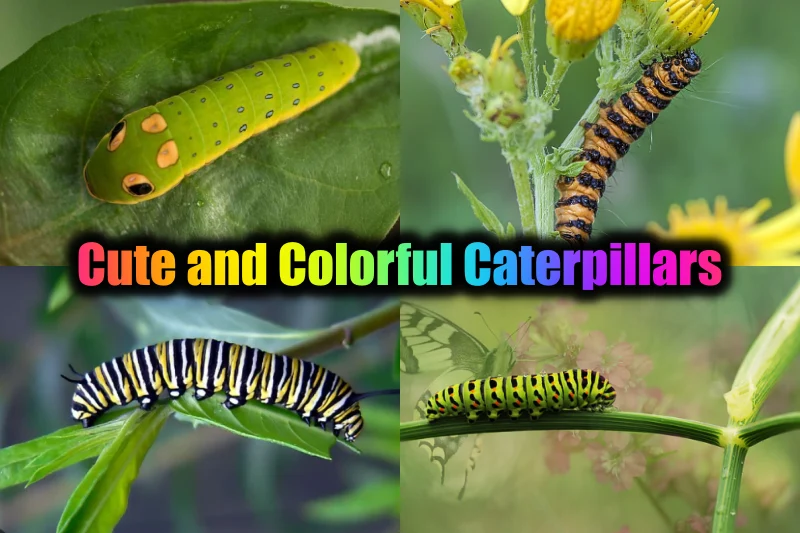The earth is loaded with wonderful creatures. All of us mostly like to see colors that are spread everywhere in the world. Among all the creatures, one has the most beautiful color and looks too cute for all beings; that is none other than the butterfly.
But do you know where these gorgeous butterflies came from? Firstly, they are in cocoons, from which we got the caterpillar, and then they become butterflies. Today we are going to look at some cute and colorful caterpillars you’ve never seen before.
Here is the list:
24 Cute and Colorful Caterpillars
1. Brown-Hooded Owlet Caterpillar
| Scientific name | Cucullia convexipennis |
| Colors | Brown, black, yellow, and orange |
| Identification | Yellow lines running down the back |
| Geographical Location | United States and Canada |
Brown-hooded owls have pale brown hair over their heads, resembling mohawk hairstyles.
The moth’s pale brown color darkens in the lower corners of the forewings, creating a streaky appearance. Also known as a brown-bordered owl.
The colorful caterpillar, also called a calico paint caterpillar, has a glossy black head with yellow lines and marks.
A deep orange line runs down the back, and the sides have short yellow and white lines. The caterpillar feeds on asters and goldenrod.
2. Lettuce Shark Moth Caterpillar
| Scientific name | Cucullia lactucae |
| Colors | Black, yellow, and white |
| Identification | black spots in white spots |
| Geographical Location | Europe, Turkey |
The forewing is dark gray with darker lines and shadings. The inner and outer lines and a median shade from the costa are distinct.
A black streak from the base along the submedian fold is present, with a black streak above vein 4 and a shorter one below vein 2 before termen.
The hindwing is brownish fuscous with a paler base, especially in the male. The larva is white, with a yellow dorsal line and a row of large, round black spots on each side.
Above the feet, yellow spots are marked with black flecks, and the head is black with a white angular marking.
3. Spicebush swallowtail

| Scientific name | Papilio troilus |
| Colors | Brown, green, yellow, blue, and black |
| Identification | Wide mouth |
| Geographical Location | Eastern US and Southern Ontario |
The spicebush swallowtail is also known as the green-clouded butterfly. Its name comes from its most common host plant, the spicebush, which is a member of the genus Lindera.
The spicebush swallowtail is found in the eastern US and southern Ontario but occasionally strays to the American Midwest, Cuba, Manitoba, and Colorado. The larvae are brownish, independent of leaf color, and can become brown (winter) or green (summer) pupae.
Spicebush swallowtails have two stages of mimicry: the early stages, where they are dark brown and resemble bird droppings, and the fourth and last instar stage, where they turn yellow-green and are marked by two large black dots with a white highlight.
Both sexes can successfully mimic B. philenor, despite the brighter blue color on female wings being slightly more vibrant than the pipevine swallowtail’s coloring.
4. Cinnabar moth Caterpillar
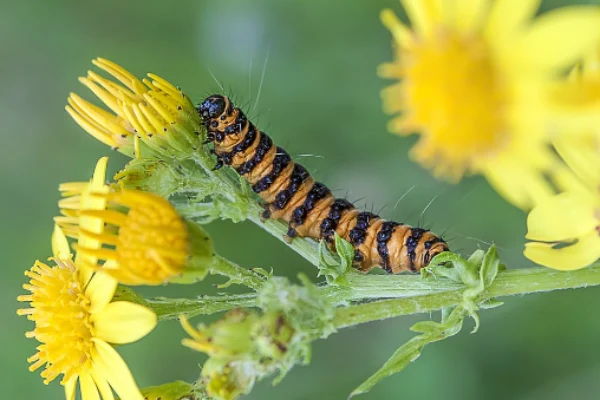
| Scientific name | Tyria jacobaeae |
| Colors | orange, black |
| Identification | horizontal orange and black lines |
| Geographical Location | Europe, Asia |
The cinnabar moth is native to Europe, western and central Asia, and east across the Palearctic to Siberia. These cute and colorful caterpillars have bright colors.
Its larvae are pale yellow, later developing jet-black and orange-yellow stripes. They can grow up to 30 mm (1.2 in).
5. Black Swallowtail Caterpillar
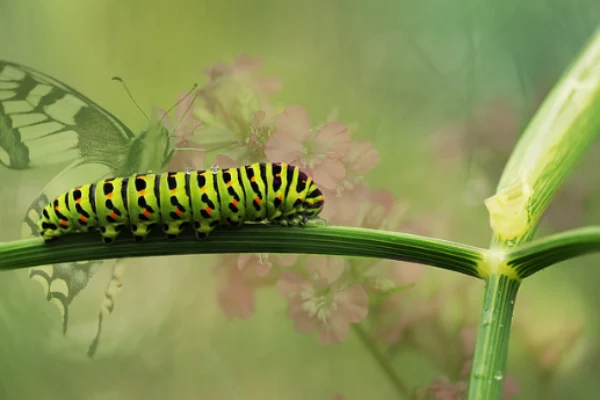
| Scientific name | Papilio polyxenes |
| Colors | Green, black, orange, white, and yellow |
| Identification | horizontal black and orange pattern |
| Geographical Location | Canada, South America |
The black swallowtail caterpillar has an orange “forked gland” called the osmeterium, which releases a foul smell when in danger. Its pupae can be green or brown, depending on their environment.
Young larvae are mostly black and white with a saddle, while older larvae are green with black transverse bands containing yellow spots.
Found in southern Canada, South America, and North America, mostly in open areas like fields, parks, marshes, or deserts. They prefer tropical or temperate habitats and may be extirpated from Cuba.
6. Banded Swallowtail Butterfly Caterpillar
| Scientific name | Papilio demolion |
| Colors | Metallic green, golden, and black |
| Identification | metallic green color |
| Geographical Location | Brunei, Cambodia, Singapore, Vietnam, Laos, and Thailand |
The Banded Swallowtail butterfly features black wings with a pale greenish macular band extending from the forewing to the hindwing.
Its hindwing has pale greenish lunulate submarginal spots and a black ocellus ringed with orange-red at the tornal angle.
The butterfly is a fast flyer found in nature reserves, flying from flower to flower. Males of this species are not typically found in Singapore, but they are known to lay eggs on top of each other to form a “string.”
7. Promethea Giant Silk Moth Caterpillar
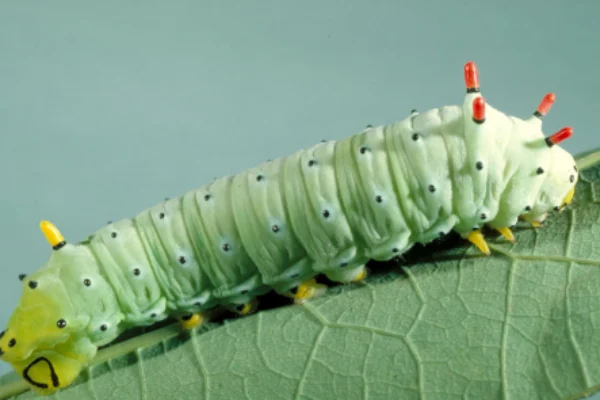
| Scientific name | Callosamia promethea |
| Colors | green, blue, red, yellow, and black |
| Identification | Four red protuberances on the head |
| Geographical Location | Eastern U.S. |
The Promethea silkmoth larvae have a yellow body striped in black and mature into bluish-green with yellow and red projections.
They undergo molts and become ready for weaving a cocoon, which is single-layered and thick. Female pupae have an indentation on their fourth abdominal segment, while their male counterparts lack it.
The pupation phase occurs in winter, mostly on trees, with caterpillars attaching themselves to branches using silk.
8. Large Tree Nymph Caterpillar
| Scientific name | Idea leuconoe |
| Colors | Orange, black, white, and yellow |
| Identification | Green horizontal lines |
| Geographical Location | Southeast Asia and Taiwan |
The caterpillar is similar to adult butterflies, with a mature larva measuring 0.5 inches in size. It has a white body with black spots and long spines.
Its head is orange in color with two black horn-like structures. Its anal plate is yellow. They are usually solitary but can form small groups of 2 to 3 individuals.
During the stage of pupa, its chrysalis is bright golden, with ten black spines protruding from the ventral side. The thorax is curved, and the antennae have multiple short black spines.
9. Forest tent caterpillar
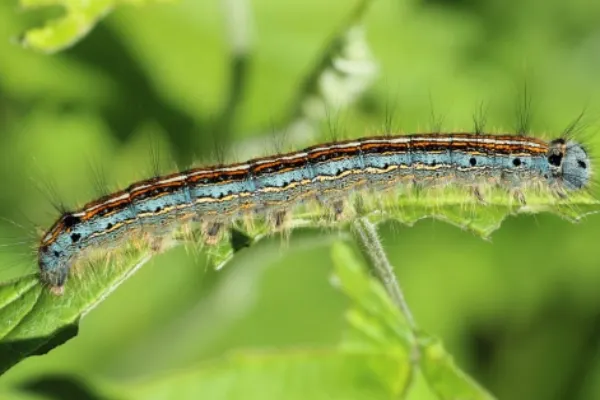
| Scientific name | Malacosoma disstria |
| Colors | Blue, black, dark brown, gray, and yellow |
| Identification | White spots on the abdomen |
| Geographical Location | North america |
Mature larvae are 2 to 2.5 inches in length. These cute and colorful caterpillars have a black, dark brown, or gray color. They had broad blue and thin yellow stripes. The back of each segment has a white spot and fur-like setae.
The adult moth emerges after pupation with a yellow or tan body and a 1.5-inch wingspan. Males and females have similar coloration, with the female body being larger than the male.
10. Gulf Fritillary Caterpillar
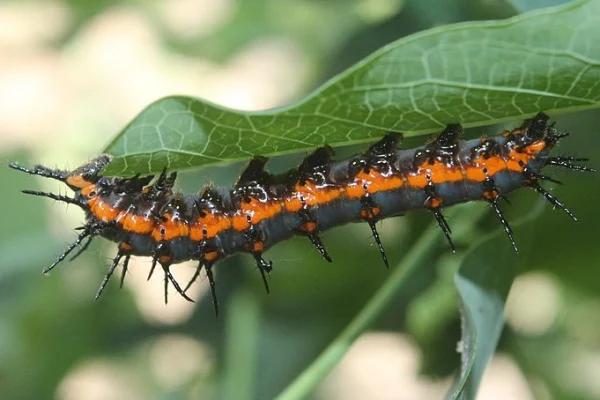
| Scientific name | Dione vanillae |
| Colors | Orange, black, gray |
| Identification | vertical orange strips down the back |
| Geographical Location | United States, and Hawaii |
Gull fritillaries have dark orange larvae with black spines. They have five instars, each with a different timeframe.
After hatching, larvae eat egg casings for food, eventually transitioning to consuming other eggs or host plant parts.
In the first three instar stages, larvae primarily consume leaves and feed away from leaf margins, depending on the leaf type.
In the last two stages, larvae mainly consume leaves and feed at leaf margins. The duration of the larval stage varies between 11 and 16 days, depending on temperature.
11. Abbott’s Sphinx Caterpillar
| Scientific name | Sphecodina abbottii |
| Colors | brown, black, and green |
| Identification | Horn at the head |
| Geographical Location | Eastern North America |
Young caterpillars are green with a horn-shaped growth at the abdomen. After one moult, they turn whitish or bluish-green, disappearing and replacing it with an orange knob.
In the last instar, caterpillars reach 7.5 cm and have two forms: brown or pale green spots on a brown background, with a large eye-like growth at the abdomen tip.
12. Variegated Fritillary Caterpillar
| Scientific name | Euptoieta claudia |
| Colors | black, orange, white, |
| Identification | orange strip running down the back with white spots |
| Geographical Location | Argentina, Central America, Mexico, Cuba, and Jamaica |
The larva, red with black subdorsal and spiracular stripes, eats leaves, flowers, and stems of the food plant. It has six rows of black spines and a pair of long, clubbed spines on the head. The red middorsal stripe bears white oval-shaped spots, one per segment.
The larva has a brownish copper color with white lines across its body, mottled with fine black spots.
These cute and colorful caterpillars are studded with small, black, spine-like growths. Found from Argentina to Central America, Mexico, the southern parts of the United States, Cuba, and Jamaica.
13. Striped Blue Crow Butterfly Caterpillar
| Scientific name | Euploea mulciber |
| Colors | white, black, pink, and yellow |
| Identification | four pairs of long fleshy subdorsal filaments with pink bases |
| Geographical Location | Southeast Asia |
Larva is a cylindrical creature with a pinkish-white body and yellowish blotches on its legs. These cute and colorful caterpillars have four pairs of long fleshy subdorsal filaments with pink bases and black tips, with three pairs on the anterior segments and the fourth pair on the 12th segment.
The segments are divided by a black line, with spiracles in black. The head has a dark red stripe in front and one on each side, and the fore and middle legs are black ringed with pink.
14. Spurge Hawk-Moth Caterpillar
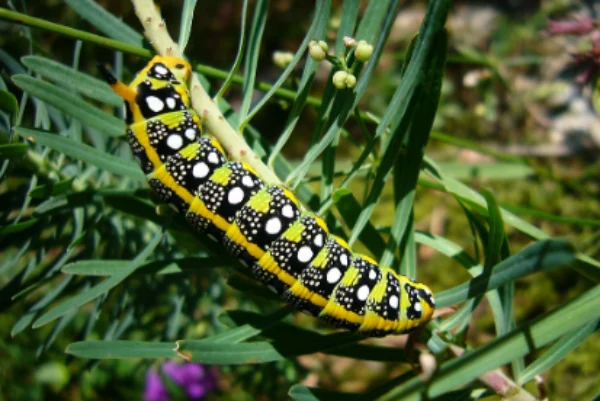
| Scientific name | Hyles euphorbiae |
| Colors | red, black,white |
| Identification | red horn at the head with a black tip |
| Geographical Location | Pontresina, Switzerland |
The caterpillar is smooth and black, with numerous whitish dots. These cute and colorful caterpillars have eleven large spots of the same color on each side of their back, and beneath them are bright coral-red spots.
The head is of the same coral-red color, and a line of the same color runs along its back, from the head to the horn. The horn is red at the base and black at the tip. The caterpillar feeds on sea spurge.
15. Zebra Longwing Caterpillar

| Scientific name | Heliconius charithonia |
| Colors | black and white |
| Identification | back spots with spikes |
| Geographical Location | Central and South America, southern Texas, and peninsular Florida |
Caterpillars are white with black spots and black spikes, with a yellow head. Chrysalis is light brown to dull yellow and camouflages. Nymphs hang in cocoons resembling dry leaves.
Adult butterflies are monomorphic, medium-sized, and have long wings. On the dorsal side, they have black wings with white and yellow stripes, while on the ventral side, they have paler red spots.
The wingspan ranges from 72 to 100 mm. Found in Central and South America, southern Texas, and peninsular Florida in the United States. These cute caterpillars migrate further north during the summer.
16. Monarch Caterpillar
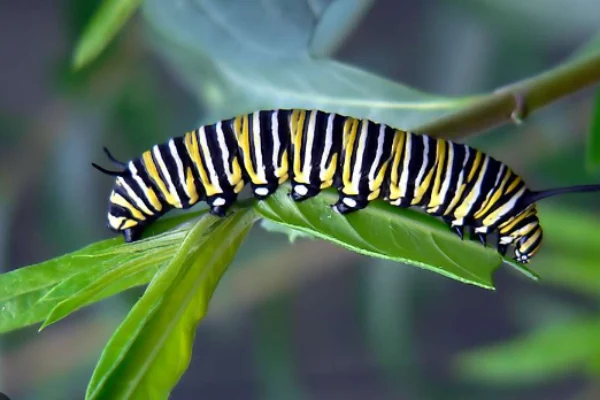
| Scientific name | Danaus plexippus |
| Colors | black, white, and yellow |
| Identification | horizontal yellow and black strips |
| Geographical Location | Mexico, California, the United States, Florida, and Arizona |
The caterpillar has five stages, each lasting 3–5 days. The first instar is pale green or grayish-white, shiny, and almost translucent, with a large black head. It feeds on milkweed in a circular motion, leaving a characteristic arc-shaped hole in the leaf.
Older first-instar larvae have dark stripes on a greenish background and develop small bumps that later become front tentacles. The second instar has a characteristic pattern of white, yellow, and black transverse bands, with a yellow triangle on the head and two sets of yellow bands around it.
The third instar has more distinct bands, and two pairs of tentacles become longer. The fourth instar has a different banding pattern, with white spots on the prolegs near its back.
The fifth instar has a more complex banding pattern and white dots on the prolegs, with front legs that are small and very close to the head.
As the caterpillar completes its growth, it is 4.5 cm long, 7 to 8 mm wide, and weighs about 1.5 g. In a laboratory setting, the fourth- and fifth-instar stages showed signs of aggressive behavior with lower food availability.
17. Blue-Striped Nettle Grub
| Scientific name | Parasa lepida |
| Colors | green, purple, yellow, and black |
| Identification | spiky body |
| Geographical Location | India, Sri Lanka, Vietnam, Malaysia, and Indonesia |
Males have a greenish head with reddish brown sides, a thorax with a brown stripe, and a brown abdomen. The forewings are pale green, and the hindwing is yellowish at the base and reddish brown towards the margin.
Females have a wider reddish-brown stripe on the thorax and a reddish-brown hindwing. Larva is pale green, and the body has three green bands, including spinous tubercles, a purple-brown cocoon, and flat, overlapped eggs covered by a transparent cement.
18. Puss Moth Caterpillar
| Scientific name | Megalopyge opercularis |
| Colors | green, black, white, red, and brown |
| Identification | big square-shaped head |
| Geographical Location | United Kingdom |
A large, furry moth with black spots on its body and forewings is known as a caterpillar. These cute and colorful young caterpillars are tiny and dark brown, with horn-like projections behind the head and long tails.
As they grow, they take on yellow, brown, and green colors to blend with their leaves.
Older caterpillars are large and mostly green, with a dark saddle-like pattern on their back and a red patch at the front. They have two long tails covered in black blobs.
19. Hickory Horned Devil Caterpillar
| Scientific name | Citheronia regalis |
| Colors | blue, green, orange, and black |
| Identification | two pairs of spikes at the head |
| Geographical Location | United States |
Hickory-horned devils are bright green caterpillars that feed during the day and molt four times. They have black-tipped red horns and grow up to 15 centimeters (5.9 in) long.
The larva changes color from green to turquoise before pupation, and they crawl down the host plant, burrow into the dirt, and pupate in a well-formed chamber. Some pupae overwinter for two seasons, possibly to adapt to adverse conditions or maintain genetic diversity.
20. African death’s-head hawkmoth
| Scientific name | Acherontia atropos |
| Colors | blue, green, yellow, and black |
| Identification | unique blue and green patterns at the back |
| Geographical Location | Europe and Africa |
Acherontia atropos, the African death’s-head hawkmoth, is the most widely recognized species in the genus Acherontia. Its caterpillar is a sturdy, variable-colored shade of buff, green, or brown with seven diagonal blue lines. It can reach 5 to 6 inches in length.
Acherontia atropos is found in the Middle East, Mediterranean region, Africa, and northern Great Britain due to mild British winters. It invades western Eurasia frequently, but few individuals successfully overwinter.
21. Wattle cup caterpillar
| Scientific name | Calcarifera ordinata |
| Colors | orange, green, yellow and white |
| Identification | Eight borns at the body |
| Geographical Location | Australia |
Calcarifera ordinata is a species of caterpillar found in northern Australia, primarily feeding on acacia leaves, orange trees, and dogwoods. Its distinctive coloration includes bright blue to turquoise tops, backs, and sides, orange markings, neon green or yellow markings, and antenna-like protrusions. Although bright caterpillars may turn into butterflies or moths, they are dull whitish with brown markings when turning into moths.
22. Cecropia Moth Caterpillar
| Scientific name | Hyalophora cecropia |
| Colors | Green, blue, yellow, red and black |
| Identification | Horns all over the body |
| Geographical Location | North America |
Hyalophora cecropia, also known as the largest native moth in North America, is a large caterpillar that lives in various habitats across North America. It feeds on maple leaves, birch, cherry, and other tree species. In its fifth life stage, it is large and green, covered with bright blue and orangish protrusions. The moth has an impressive wingspan of 5-7 inches and was discovered early on, similar to the hickory horned devil.
23. Queen Butterfly Caterpillar
| Scientific name | Danaus gilippus |
| Colors | Black, yellow, and white |
| Identification | Three pairs of horn-like protrusions |
| Geographical Location | North America and South America |
Danaus gilippus, also known as the queen butterfly caterpillar, is a striking caterpillar found in various habitats, particularly in marshes, meadows, and fields in North America and South America. It measures around 1″ long and primarily feeds on milkweed plants. The caterpillars are white, banded with black, and have yellow spots, with three pairs of horn-like protrusions. Some fully grown queen butterflies may resemble adult monarch butterflies.
24. Grass moth caterpillar
| Scientific name | Acronicta rumicis |
| Colors | Blue, black, orange and white |
| Identification | Hair on the body |
| Geographical Location | United Kingdom |
Acronicta rumicis, a distinctive blue caterpillar, inhabits various habitats in the Palearctic region and is about 1.6 inches long. They feed on low-growing plants and fruit trees.
Despite their attractive appearance, these caterpillars cause significant crop pest issues. Research has focused on their decline in the UK, where they are included in the Priority Biodiversity Action Plan to preserve numbers and increase their size.
Conclusion:
These are some cute and colorful caterpillars. These caterpillars are commonly seen in your surroundings. The most exciting thing is that these caterpillars have different colors on their bodies.
Most of them have shiny bodies; some have spikes and hair. However, this is it for today. We will be back with some more informative articles. Till then, stay tuned to How It See.
Also Read:

As a content writer, I like to write about different niches. I have a curiosity about nature and animals. And like to learn about them. Through my writing, I like to share my experience and knowledge with you. I hope you are enjoying it too.
